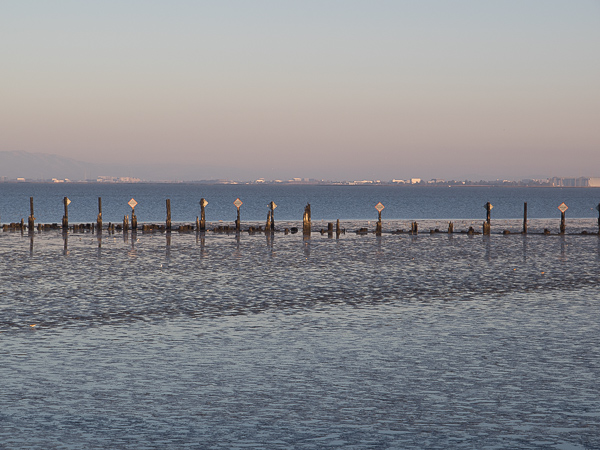
After being on a waiting list since mid September, I finally got my hands on Olympus’s new flagship camera, the OM-D E-M1, last Friday. This is not really a review as such, as I only used the camera for a couple of days. Here are my impressions, particular vis a vis my current camera, the E-M5:
Size and Appearance
The E-M1 is bigger than the E-M5, on account of the grip. On the one hand, it’s an ergonomic rubberized grip which makes the camera more comfortable with larger lenses, or for those with larger hands. On the other, it more or less ruins the classic profile of the camera and the increased size can be a nuisance with cases and bags. I wish they’d stuck with the size and styling of the E-M5 and made the bigger grip an optional add-on (like the E-M5).
Overall build quality seems slightly more solid. I gather that underneath there’s a much more extensive magnesive frame than the one the E-M5 had. In any case, it feels nicer in the hand.
Controls
Although many of the buttons on the camera are still small, they’re not quite as small the ones on the E-M5, and the four-way controller no longer feels mushy. Olympus added an interlock to the mode dial, so it can’t be accidentally changed either. One clear step backward was moving the on/off switch to the only location worse than where it already was – the left side of the camera where you can’t reach it with your right hand (when holding the camera).
A significant change is the shutter button which is now ‘soft touch’. This makes it easier to push and release without shaking the camera, but it also makes it easier to accidentally get an exposure when you’re just trying to half-press to engage the autofocus and/or metering.
Image Quality
Images look identical to the E-M5. Despite the supposed removal of the low pass filter, there’s no improvement to sharpness. They did add automatic removal of lateral chromatic aberration for both Olympus and Panasonic lenses to the processing engine, so if you shoot JPEGs, you will see some nice improvements.
The only place where I noticed a difference in the quality of the output was for long exposures without dark-frame subtraction. Here, the E-M1 was much noisier than the older camera. Considering that most folks use DFS for long exposures, I don’t think it’s a big deal, but if you’re into astrophotography, the E-M1 is probably the wrong Olympus m4/3 body for the job.
Autofocus
One major difference with the E-M5 is that for autofocus, the camera has phase detection built into the sensor. In theory, this should mean much better tracking autofocus and much better autofocus with 4/3 (non micro) lenses. I only tested tracking AF briefly, and it seemed decent.
Autofocus with 4/3 lenses is a mixed bag. In good light, it’s usually much faster than on the E-M5. In poor light, it slows down and occasionally fails altogether. It’s never quite as fast as the autofocus with native micro 4/3 lenses, but in the best case, it’s close. The major limitation is that the sensors only detect contrast vertically, so horizontal lines are all but impossible for it to focus on. I hit this issue a number of times, and even in good light it led to complete focus failures. While it’s considerably better than the situation with the E-M5, it’s still not good enough to rely upon in my view.
Features
The E-M1 improves on the E-M5 in a number of other ways. The viewfinder is nearly twice the resolution and much bigger than the E-M5’s. It’s still not as pleasant to look at as a good OVF, but you definitely notice the difference in size and resolution when using it. The rear LCD has also seen its resolution upgraded, to 1MP. There’s now WiFi to let you control the camera from your smartphone and download your images. The top shutter speed is up to 1/8000 second so shooting in daylight with bright lenses wide open should be easier. There’s a flash sync port for those with fancy flash systems. Optical image stabilization in Panasonic lenses can now be enabled in the camera, so it works for all Panasonic lenses with OIS including those without a physical switch. I’m sure I’ve left out a bunch of other additions, but those were the ones I noticed.
Overall Impressions
The E-M1 is a nice solid camera. In spite of being the size of an entry-level DSLR, it handles like a high-end camera and it really has no obvious flaws (well, other than where they put the on/off switch). That said, I haven’t really bonded with it. Partly that’s on account of the size, but mostly it’s the aesthetics and the ergonomics of the new grip. It lacks the classic look of the E-M5, and while it’s an obvious upgrade in many respects, it fails in two important respects: it doesn’t focus my 4/3 lenses well enough to rely upon, and it doesn’t improve the basic image quality. I expect many people will find it perfect for their uses, but given those reservations and the significant price, I don’t expect to keep mine for long. Fortunately, there are a lot of people on the lookout for lightly used ones at discounted prices.
